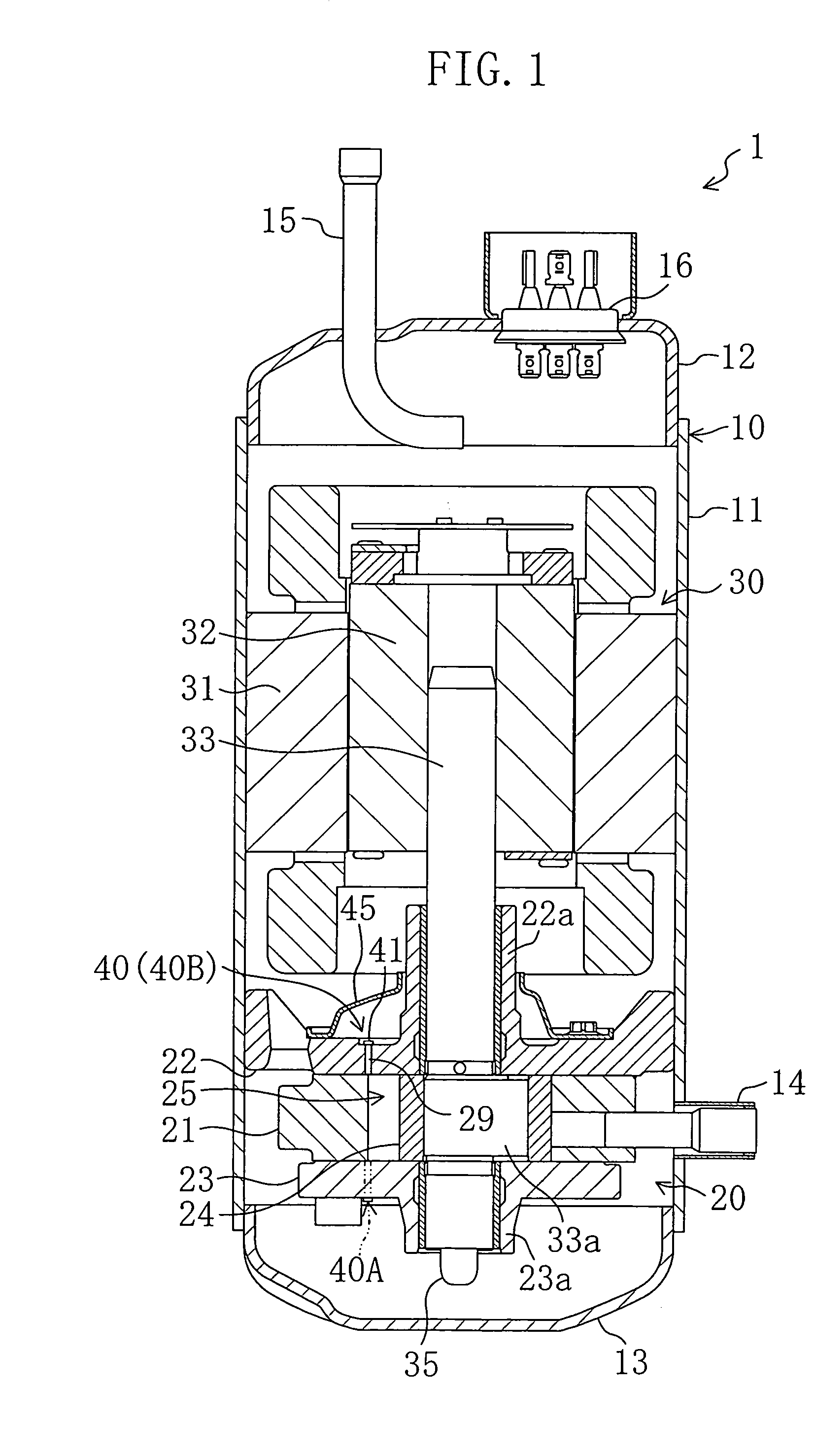Discharge valve mechanism for variable displacement compressor
a compressor and variable displacement technology, applied in the direction of machines/engines, positive displacement liquid engines, liquid fuel engines, etc., can solve the problems of overcompression loss, inability to compress refrigerant to excess, and difference diminishing, so as to prevent the rise in cost, improve the operating efficiency of compressors, and improve the operating efficiency. the effect of the operating displacemen
- Summary
- Abstract
- Description
- Claims
- Application Information
AI Technical Summary
Benefits of technology
Problems solved by technology
Method used
Image
Examples
first embodiment
of the Invention
[0056]Hereinbelow, a first embodiment of the present invention will be described in detail with reference to the drawings.
[0057]The first embodiment relates to a compressor (1) of a rotary piston type. Referring to FIG. 1, the compressor (1) comprises a casing (10) in which there are disposed a compression mechanism (20) and an electric motor (drive mechanism) (30) for activating the compression mechanism (20). The compressor (1) is of a fully closed type. When the compression mechanism (20) is powered by the electric motor (30), the compressor (1) sucks in a refrigerant and compresses it. The refrigerant compressed is discharged out of the compressor (1), and circulates in a refrigerant circuit.
[0058]The casing (10) comprises a cylindrical main body part (11) constituting a peripheral wall of the casing (10), and end plates (12, 13) fixedly secured to upper and lower ends of the main body part (11), respectively. In addition, both of the compression mechanism (20) a...
modification example
of the First Embodiment
[0083]Referring to FIG. 4(a) which illustrates an example of the valve element (41), the small-width part (41a) is formed which is situated between a portion of the valve element (41) corresponding to the first discharge opening (29a) and a portion of the valve element (41) corresponding to the second discharge opening (29b). Alternatively, as shown in FIG. 4(b), the valve element (41) may be formed into such a shape that it includes a small-width portion (41b) corresponding to the first discharge opening (29a). This arrangement also enables the leading end portion (41b) of the valve element (41) corresponding to the first discharge opening (29a) to easily bend. As a result, the first discharge opening (29a) is quickly placed in the open state during the small-displacement operation, thereby achieving high-response operations. In addition, both the discharge openings (29a, 29b) are placed in the open state during the large-displacement operation. Accordingly, ...
second embodiment
of the Invention
[0084]A second embodiment of the present invention is an example which differs from the first embodiment in that the discharge valve mechanism (40) has a different structure.
[0085]The discharge valve mechanism (40) of the second embodiment comprises a first valve mechanism (40A) disposed on the rear head's (23) side (as indicated by virtual line of FIG. 1), and a second valve mechanism (40B) disposed on the front head's (22) side.
[0086]As shown in FIG. 6, in the second embodiment, the first discharge opening (29a) is formed in the rear head (23), and the first valve mechanism (40A) is configured so that the first discharge opening (29a) is placed in the open or closed state by a first valve element (41A) which is a reed valve. In addition, as shown in FIG. 5, the second discharge opening (29b) is formed in the front head (22), and the second valve mechanism (40B) is configured so that the second discharge opening (29b) is placed in the open or closed state by a secon...
PUM
 Login to View More
Login to View More Abstract
Description
Claims
Application Information
 Login to View More
Login to View More - R&D
- Intellectual Property
- Life Sciences
- Materials
- Tech Scout
- Unparalleled Data Quality
- Higher Quality Content
- 60% Fewer Hallucinations
Browse by: Latest US Patents, China's latest patents, Technical Efficacy Thesaurus, Application Domain, Technology Topic, Popular Technical Reports.
© 2025 PatSnap. All rights reserved.Legal|Privacy policy|Modern Slavery Act Transparency Statement|Sitemap|About US| Contact US: help@patsnap.com



